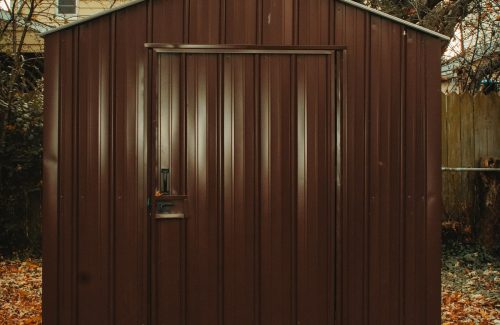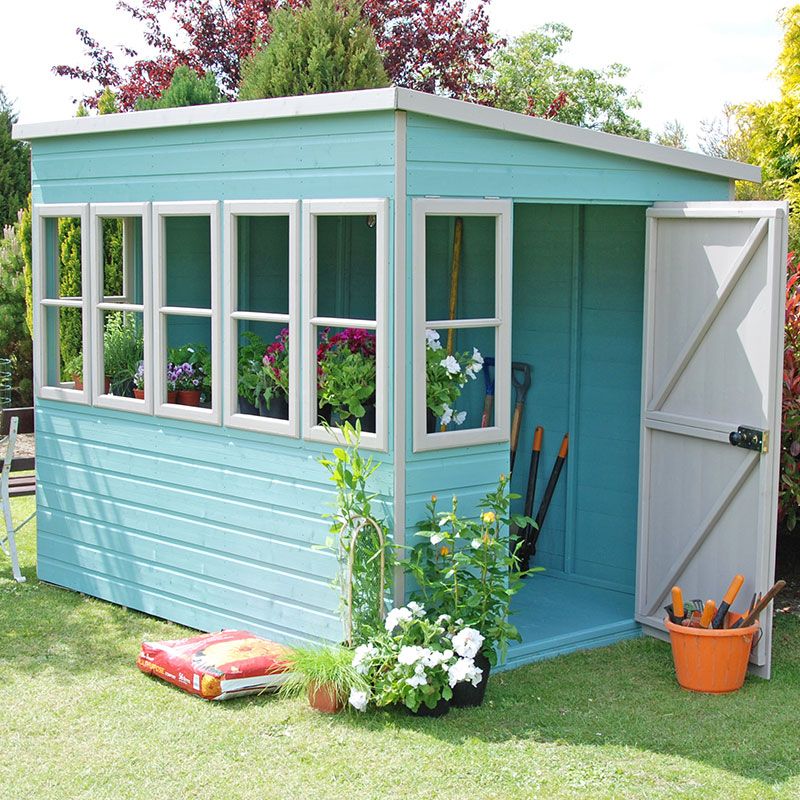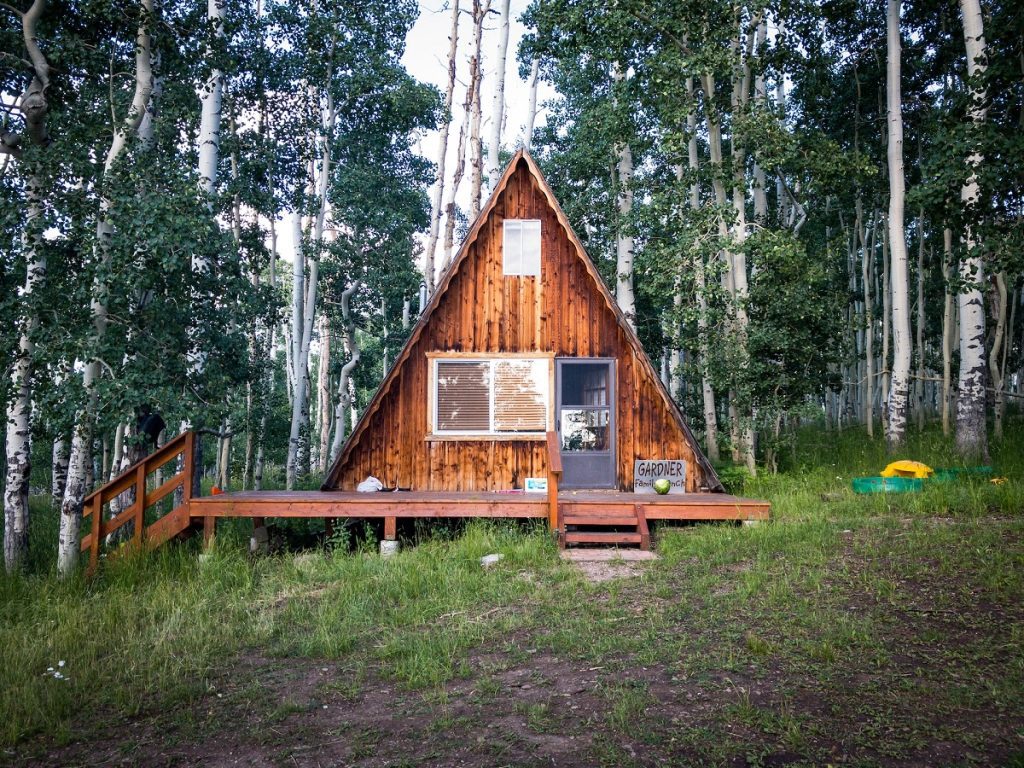Shed Types
When choosing what kind of shed type you want to build, the choices are nearly endless. Sheds come in so many shapes and sizes that it could take you days to actually decide on the one you want.
This article will introduce you to all the major and common shed types that can be found. They’ll be organized based off style, materials, roofing, flooring, size, foundation and use.
Virtually all of these categories can be mixed and matched to your preference. Read through them, pick your favorite ones, and you’ll be well on your way to building your perfect shed.
Styles

Gambrel Sheds
Gambrel sheds are popular because they have a specific kind of sloped roof which makes them ideal for storing larger items if the shed is big enough itself.
Because of their roof shape, they are also a common choice for people who want to build a loft or second floor as well for extra storage.
They make great choices for people that need extra room to store a spare car away during the winter season.

Gable Sheds
Out of all the shed types available, the gable shed may very well be the most common one of them all. As a result, they come in many shapes and sizes and are easy to find.
Gable sheds are very versatile and can look good on almost any property, be it in the woods or in the suburbs. They tend to work best as a wood shed or workshop. They can also be used to store motorcycles, lawnmowers and other larger tools of this sort.
Some of the most common sizes for gable sheds are 10×10 shed or 10×12 shed.

Lean To Sheds
Lean to sheds are easy to build and are very beginner friendly for anyone looking for a DIY project. They tend to be constructed while being attached to a part of your home or garage as opposed to being a free standing building.
Because they tend to be made so close to the house, they are often used to keep gardening tools, indoor gardens, a garden gym shed, as a greenhouse or a pool pump shed.

Saltbox Shed
You may have never heard of the term, but saltbox shed types are unique thanks to their versatile functionality and their unique looks.
They tend to be built small, with many saltbox sheds coming in at 4×8 shed or 12×8 shed.
They are very heavily sloped or slanted which means they are not good for storing larger objects. They are ideal, however, as a garden bike storage, a she shed or a tool shed.
Because the roofs are so sloped, they can be difficult to build despite being smaller than average sheds. This makes them not the best choice for DIY projects but they typically aren’t too expensive if getting a contractor to build it.
Materials

Vinyl Sheds
Vinyl sheds are common because they are by far the cheapest sorts of shed types money can buy. This also makes this material fairly popular for build your own shed kits as well.
While vinyl isn’t the most shock resistant material, it is waterproof. Plus you never need to worry about vinyl shed types succumbing to rot, moisture damage or termites as you would with a wooden shed.
One downside however is that vinyl sheds do not look appealing to many people, so they will probably not do anything to improve your property value.
Vinyl sheds come in all shapes and sizes, including 12×12 shed sizes or even 12 x 16 shed sizes. They are used for a wide variety of purposes including bike storage, sports equipment storage and more, but they don’t make very good pool pump sheds, workshop sheds, hot tub sheds or anything that is more complex and heavy duty.

Metal Sheds
Most metal sheds are made out of steel, aluminum and sometimes iron. Metal shed types are good choice because they last a very long time and have great durability. And because they aren’t wood, they won’t succumb to moss, mold, fungus or insects.
Metal shed types are also a great choice for security purposes as they are harder to break into compared to a wooden or vinyl shed type. This makes them great for storing valuable items like cars, motorcycles or anything large and expensive.

Wooden Sheds
Shed types made out of wood are by far the most popular shed type and for many reasons. For one thing, they tend to be the most visually appealing by far. Most sheds are pretty big, and no one wants an eyesore on their property, especially if it will lower the property value. Wooden sheds, as a result, are also among the most expensive types.
Wood shed types fit in with the environment and outdoors much easier than any other, so they have more options when it comes to placement. A vinyl shed ought to be hidden away in a corner, but a wooden shed can be part of your garden’s décor and vibe easily.
Wooden sheds do require maintenance as they can succumb to insect infestation or water damage from rain and snow. This is another reason why they can be the most expensive of the shed types.
Roofing

Sheet Metal Roofing
Sheet metal roofs are one of the most popular roofing types for sheds. They’re not too heavy, they’re easy to install and they have few cons. They also tend to last for a very long time before needing replacement, but because they are easy to install, replacement procedures are usually quick and painless.

Clay Tile Roofing
Clay tiles and wooden shed types go together like peanut butter and chocolate. While they look good and offer solid protection, they can be a little hard to install because they are thicker and heavier than most other roofing materials.

Roofing Shingles
Roofing shingles are common because their purpose is to make your shed look more like your house. This makes them a fairly popular choice for roofing in general, but they are especially common for sheds with a porch or a shed bar.
Roofing shingles need to be replaced or inspected roughly at the same intervals that your own home needs a check-up so they are considered a low-maintenance, no-nonsense kind of roofing.

Vinyl Roofing
As you might expect, vinyl roofs are most common with vinyl shed types. They have some more purposes than just that, though. They can be used as the roof for a metal shed though this is rare.
They are good for protection against water and snow but they aren’t the best for large crashes from falling trees unless reinforced with metal, usually steel.

Green Roofing
Green roofs are almost exclusively made for wooden sheds, so they won’t be for everyone. They also have a particular look that can’t be customized very much so people going for visuals may find them too limiting.
But they have a very cozy look and unique function that will be a perfect choice for some people. They are made with a waterproof coating that is superb at protecting the roof of your wooden shed from excessive rainfall and subsequent water damage.
And, as the name implies, the roof looks completely green so this can be a great choice for homeowners who live closer to the woods and have a lot of trees adjacent to their property line.

EPDM Rubber
Rubber roofing is a lot less common but it can be a real good idea. It isn’t the most durable roofing material out there but it is easy to install and easy to repair.
It isn’t a good option for pitched roofs but works great as a flat surface roof. This makes rubber a good pairing with metal sheds of smaller sizes.
Rubber is also very easy to work with so you can get a rubber roof of just about any size pretty easily. It won’t break the bank either.
Shed Sizes
Small Shed Types
A small shed is a perfectly good choice if you only need a little extra storage for any smaller tools. A general rule of thumb is that if you’re only storing stuff smaller than a ladder or step-ladder, you should go for a small shed.
Small sheds are very quick to build and install so they are a common option for people setting out to build their very first DIY shed. They tend to be around the size of large closets and are great for storing workshop tools or gardening items.
Small sheds also take up very little space on your property so they tend to be made out of materials that aren’t the most visually appealing. Small sheds tend to use rubber, plastic, metal or vinyl.
Expect a small shed type to be as small as a 4×8 shed.

Medium Shed Type
Medium sheds are the most common shed size type. They are great for holding both small and medium sized items including wheelbarrows, ladders, weed whackers, riding lawnmowers and chainsaws.
Medium sheds are certainly more expensive and take longer to build than small sheds, but they are necessary if you have any larger tools that need to be secured or protected from the weather.
They can come in any material so you will see medium sheds made out of anything from high quality imported wood to simple vinyl or plastic.
Expect medium sized sheds to be at least a 10×10 shed size.

Large Shed Type
A large shed may not be what you need unless you have a lot of tools you want to store away. They’re not quite the size of a garage but they are capable of fitting at least one car.
Large shed types tend to come in sizes around 20×20 shed, but they can be a little smaller or larger. There’s a lot of wiggle room once you get to this size.

Very Large Shed Type
If you really want to go big, you can feel free to build yourself an extra large shed. These things are massive and tend to be even bigger that house garages.
These are very expansive and expensive projects so you should only opt for one if your storage needs are truly at max capacity.
Very large shed types are also great options if you want an at-home office or a small workshop alongside the extra tool storage. They are great choices for people who have extra firewood, for example.

Flooring
Flooring Materials
The floor of your shed is one of the most important factors to consider when building it. It’s arguably more important than the walls or roof because you want something that will keep your items secure but may also want a material that won’t get scuffed up by them.
Timber wood floors are a common choice as they aren’t too hard to install and tend to look nice. They’re comfortable to walk on if you plan on having a shed that is at least medium sized. They’re also stronger than plywood, although a bit more expensive.
Flooring Insulation
Floor insulation for a shed is considered very important, but only if the shed is built in a way that makes it connected to your house.
Insulation is typically only meant for large or extra large shed types that feature a home office of some sort. The purpose of the insulation is to keep the temperature inside the shed bearable, otherwise it will be too hot in the summer and too cold in the winter. In other words, flooring insulation is what allows sheds to have regular room temperature.
Flooring Ventilation
Ventilation is important for sheds of all types and sizes. You want moisture and air to be able to flow freely or you could get too much accumulated dampness. This is especially a problem if your shed is made out of wood or you are using it to store wood.
Improper ventilation, or none at all, can also weaken the structural integrity of your shed. Too much moisture can make the walls or roof shift too far, causing the entire structure to collapse over time.
There are water-resistant membranes you can install on the roof to help with ventilation. They are compatible with all sorts of shed types.
Foundation
Concrete Foundation
Concrete is a great foundation choice for larger, heavier sheds that need to store bigger objects. Concrete also pairs well with sheds made out of metal or sheds that are going to be storing a lot of metal.
Concrete bases are also very hard, making them extremely stable and resistant to shed settling. If your property has unlevel ground, a concrete foundation will be a great way to compensate.
Post and Beam Foundation
If you want a simple and quick job or only need a smaller shed type, consider going with posts and beams. As long as you have wood, a saw and a measuring tape you can make them pretty easily all by yourself.
Post-and-beam foundations are pretty versatile as they can be installed and planted in different kinds of grounds. It doesn’t matter if the soil is hard or soft, nor does it matter how level the ground is.
Pier Foundations
Instead of going for wood, you may want to go for concrete piers. This involves having holes drilled into the ground that has concrete poured into them. They are similar in theory to how post-and-beams work but are much stronger.
And, as the name implies, they work well if you live near water or near a pier, as moisture from this area will not work well with wooden foundations.
Gravel Pad Foundations
Like concrete, gravel is a great foundation idea as it is hard, heavy, stable and versatile. It is also very easy to add more gravel to the foundation if you find that you need your shed to handle heavier storage items, a pro that cannot be found with concrete foundations.
All you need is a barrier to mark the gravel spot and pour away. Keep in mind that this needs to be done on level ground, so gravel pads are easier to install but can’t be done in as many locations as concrete foundations.
Cement Block Foundations
If you can get your hands on them, cement blocks work well as shed foundations. They surprisingly don’t have the stability of regular cement foundations but they can be installed quickly.
They need to be placed on level ground just like gravel pads so keep this in mind. You also should stick to using this foundation type for medium sized shed types as cement blocks can’t handle heavier storage items like cars or lawnmowers.
Shed Use

Tool Storage
It will come as no surprise to everyone that tool storage is the most common use for sheds of all sorts. Regardless of who you are – if you’re a homeowner, you probably have tools, and they probably need to be stored in a neat manner.
A shed designed for tool storage ought to be placed near the garage or close to wherever you do most of your work.
Depending on the size and number of tools you have, a small sized shed could be all that you need. Feel free to opt for a bigger size if you have large power tools like saws that also need their own space larger than a toolbox.

Garden Office Sheds
Garden offices are wonderful ways to give yourself a private place outside the main home and away from the family. Everyone needs some peace and quiet, whether it be for work or for relaxation. This is why garden office sheds are typically installed in the backyard where everything is beautiful and tranquil.

Firewood Storage
Firewood can be tricky to store. You don’t want to keep it in the main house because it can be dirty, but you also don’t want to pile them up outside where they can be hit with rain or insects.
This makes sheds a popular method for safely and neatly storing any firewood you need. You typically only need a small sized shed for this purpose, but who knows, you could have trees worth of the stuff and need to go bigger.
Sheds are also a great way to keep firewood nice and dry, especially if your shed has proper ventilation and insulation.

Personal Storage
Not everything that needs to be put into a shed is a lawnmower or a hammer. Sometimes you just need to have extra space to store away things that are simply personal or valuable to you.
Maybe you have an old antique motorcycle or sedan that you’ve had for 40 years and it needs its own special resting place. Or perhaps you simply live in a small home and just need more room to store any old furniture, paintings or clothes.



